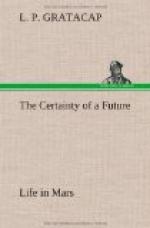“I looked upward to Chapman, who was then peering with hand raised to his eyes at some object before him which the Superintendent had pointed out, and I felt sorrowful that he should be in disagreement with this life. It boded ill. I had begun to love Chapman, and the first sense of suffering I had felt seemed now awakened at the thought of harm coming to him.
“But there was no time for meditation. Chapman and Alca were looking backward and shouting. They beckoned with their arms, and as I gazed I saw between them, and ahead of them a great black object, about which a number of the little workmen were running excitedly like a swarm of ants. I leaped to their position. Chapman exclaimed: ’You remember the meteor we saw. Well, there it is.’
“Extended like a gigantic and deformed missile lay an iron meteorite before us, the same thing as the Siderites that appear in your Museums on Earth. It was yet warm, a crevice spread down into its interior, and it had apparently rolled from the spot of its first impact, since a hammered side, abraded and worn on the hard rock, lay uppermost. It bore the significant pits, thumb-marks and depressions of the terrestrial objects, while streaming striations spread from its front breast where the iron in melting had run like tears over its surface. It measured some four feet in length, and must have weighed many tons.
“Then a curious thing happened, or seemed to happen. Alca, the Superintendent, advanced to it, and bending against it with outstretched arm, muttered a few words, frowned as if in concentrated thought, and—was it credible—the iron object moved. I looked aghast at Chapman, who turned away with what I dismally interpreted was an expression of disgust. I pressed up close to him, and he murmured, ’Was that a miracle? If it was I should like to get back to common sense and jack-screws.’
“We continued upward, and now the terrific gulf piercing the ground for over two terrestrial miles yawned at our feet. The steep precipice, lost in a twilight dusk below, was disconcerting. The blocks of stone were hoisted from the gigantic pit by hoists worked by hand. Here is one of the anomalies of this existence in Mars. Electrical science and its application is understood, great stores of mechanical experience and wisdom can be drawn on, and yet in most of the mechanical work, hand work, the toilsome method of the Pharaohs of Egypt prevails. There are no railroads or trolleys or steam vehicles. The boats are driven by explosive engines, and there are electric carriages of velocity and power. But the latter are infrequent. The canals are numerous, especially about Scandor, and the great trunk canals are broad avenues of traffic.
“The intense swift motion of the Martians meets their needs in most cases. Where hard labor on a mammoth scale is necessary, the little race of prehistorics serves all their purposes. The canals are their great engineering feats, and the wonderful telescopes, their triumphs in applied science, their knowledge of the transmutation of the elements,—their greatest intellectual victory,—and Scandor, the City of Glass, their architectural gem and miracle.




